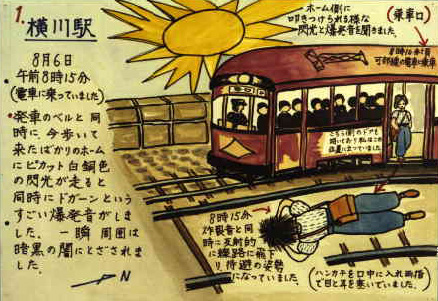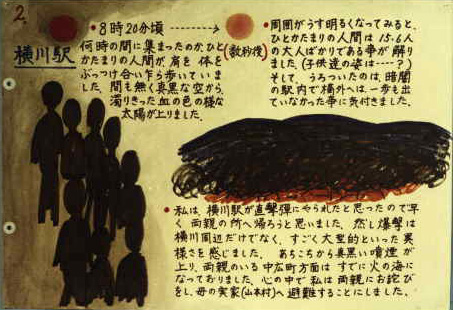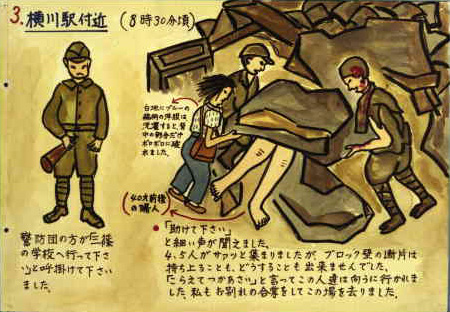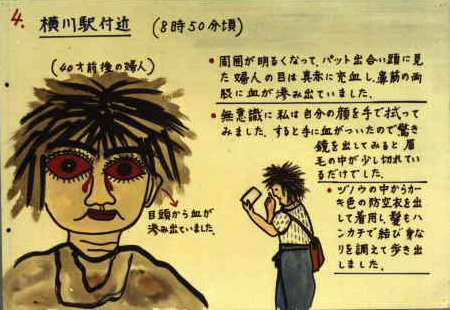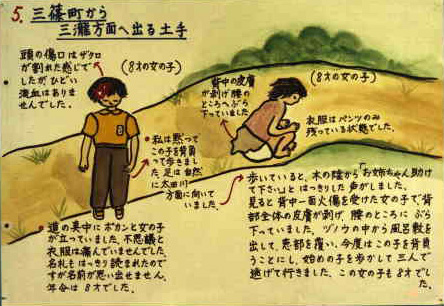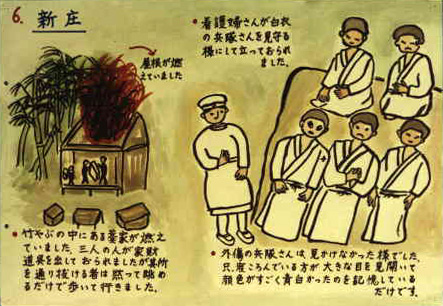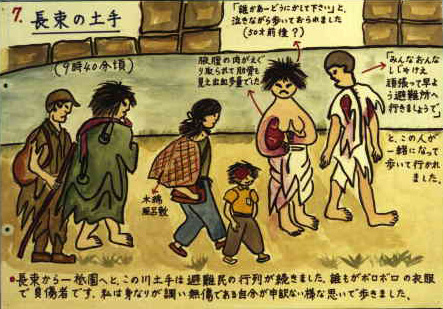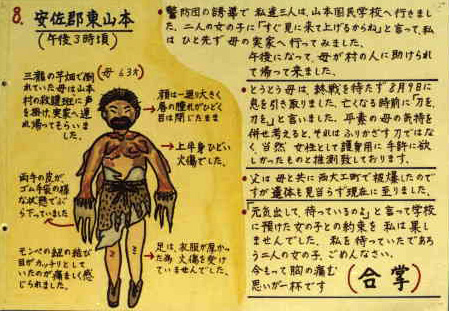Tomiko Konishi was a young
girl the day the atomic bomb
hit Hiroshima.
Years later, at age 58, she
drew a series of images to
relate her experience.
Her drawings—with text
translated to English—follow.
1. At Yokogawa Station August 6, 1945, 8:15 A.M.
I got on a streetcar of the Kabe line about 8:10 A.M. The door was open and I was standing there. As I heard the starting bell ring, I saw a silver flash and heard an explosion over the platform on which I had just walked. Next moment everything went dark. Instinctively I jumped down to the track and braced myself against it. Putting a handkerchief into my mouth, I covered my eyes and ears with my hands.
2. About 8:20 A.M. at Yokogawa Station
I do not know when they had gathered, but a crowd of people were reeling and colliding with each other. Soon the sun appeared blood-red in the dark sky. When it became a little lighter around me I saw a group of 15 or 16 adults. "Where had the children gone?" I wondered. Black smoke was rising here and there and Nakahiro-cho where my parents lived was already in flame. Apologizing in my heart to my parents I decided to seek shelter.
3. Around Yokogawa Station about 8:30 A.M.
I had worn a white blouse with a blue striped pattern that day. The back fell apart later when I washed it. A civilian guard told us, "Please go to the school in Misasa." I heard a woman saying in a small voice, "Please help me." Four or five people got together immediately to help her. But we couldn't move the concrete block off her no matter how hard we tried. Saying, "Forgive us," the others left her as she was and went away. I prayed for her and then also left.
4. Near Yokogawa Station about 8:50 A.M.
A lady about 40 years old was bleeding from her eyes. It was getting light and I met a lady whose eyes were bloodshot. The blood was oozing down from the corners of the eyes along both sides of her nose. Unconsciously I wiped my face with my hands and I was surprised to see that there was blood on them. I got my mirror out of my pocket and looked into it. I found only a small cut on my eyebrow. I took my khaki air-raid dress out of my bag and put it on, tied my hair with a handkerchief, dressed myself neatly and started walking.
5. The river bank from Misasa to Mitaki
A girl was standing in the middle of the road staring vacantly. Strange to say, her clothes were not tattered. She was eight years old. The wound on her head looked like a cracked pomegranate. Silently I carried her on my back and headed in the direction of the Ota River. Then I heard a girl's voice clearly from behind a tree. "Help me, please." Her back was completely burned and the skin peeled off and was hanging down from her hips.
6. Shinjo near Gion Bridge
A straw-thatched cottage among bamboo bushes was burning. Three persons were taking furniture out. The passers-by did not help them. They glanced at them and silently continued on their way. A nurse was standing near the soldiers in white as if she was watching over them. The soldiers did not appear wounded to me. What I remember is just the pale face and the wide-opened eyes of one soldier lying there.
7. At the bank of the Nagatsuka around 9:40 A.M.
The refugees walked in procession along the bank of the river toward Gion. There was nobody who was wearing good clothes or was without wounds except me. Everyone was in rags and hurt. I walked feeling guilty because only I still had nice clothes and was not wounded. A woman was walking, crying, "Can anyone help me?" The flesh of her side was scooped out and bleeding profusely and I could see her ribs. A man began to walk beside her, saying, "Everyone has the same pain as you have. Endure it and we will seek a shelter."
8. Higashi Yamamoto, Asa County My mother, 63 years old.
While lying on a potato farm in Mitaki my mother had asked the rescue party from her village for help and they brought her home. Her face was larger than usual, her lips were badly swollen, and her eyes remained closed. The skin of both her hands was hanging loose as if it were rubber gloves. The upper part of her body was badly burned. My mother passed away on August 9 before seeing the war end. My father who was in Daiku-cho at the time of the explosion, just as my mother was, disappeared and we have never even found his body.
